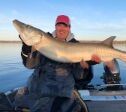- 0



By SkunkedAgain · Posted



By CigarGuy · Posted
.thumb.jpg.5c1a86e9339e49e53f5bfefed2220054.jpg)
By LakeofthewoodsMN · Posted

By Brianf. · Posted
By using this site, you agree to our Terms of Use and Privacy Policy. We have placed cookies on your device to help make this website better. You can adjust your cookie settings, otherwise we'll assume you're okay to continue.

Question
Slyster
I have couple questions for anyone who uses the Eagle 480 line...
1- I bought the 480DF for local metro lakes.. is there any drawback to buying the dual frequency model? I wish I hadn't now. I bought it before I found out that the 50mhz is more for DEEP water.. as in the ocean. Is the standard 480 better in regular local lakes then the DF in any way... or is it just as good? Seem documentation states smaller cones with the DF? I hope I didn't make a costly mistake?
2- I tried it out today for the first time. SO much clutter on the screen at the default "reset" settings. Couldn't see anything.. then I tweak and can't tell heads from tails... either full of junk or WAY too many fish finds with fish alarm- must be false.. can't be THAT many fish in the water... I don't get it... is this normal? or what settings to have to tweak to get it set right?
3- I also seem to have a double bottom image (an echo) which used up half my screen? Is this normal? Any tips on how to avoid this? This bothered me since only 1/2 the screen was showing the actual view!
Link to comment
Share on other sites
10 answers to this question
Recommended Posts